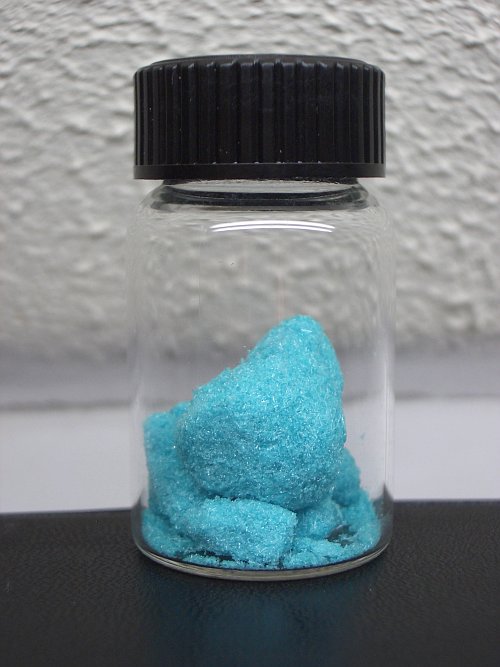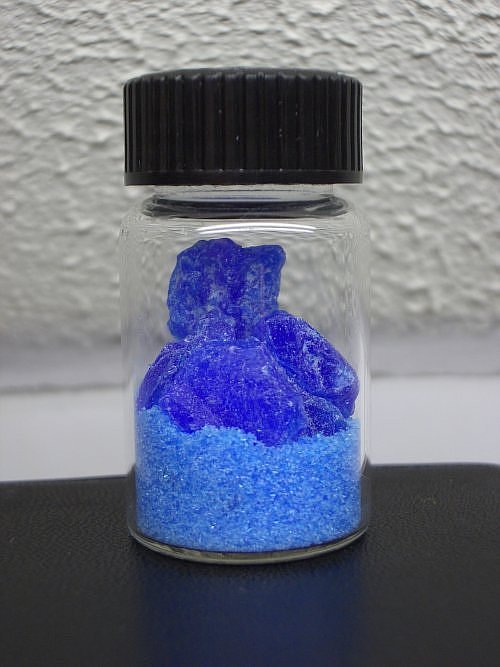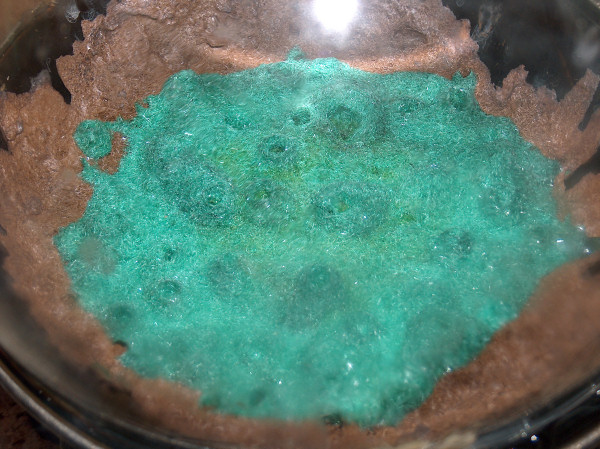tom_servo
Hazard to Self
 
Posts: 52
Registered: 11-11-2008
Member Is Offline
Mood: No Mood
|
|
CuCl2.H2O to powder?
Ok so I've been lurking around for a while and I have a question.
I've taken 60ml of H2O2 (3% Peroxide)
and 30ml HCL (Muratic Acid 31.??%)
and added some copper wire (inside of Coax cable)
Stirred magnetically on stir plate until all copper was dissolved
I presume now it is CuCl2.H2O
How would I make it into powdered form?
|
|
|
woelen
Super Administrator
        
Posts: 8014
Registered: 20-8-2005
Location: Netherlands
Member Is Offline
Mood: interested
|
|
You don't have CuCl2.H2O, but you do have copper(II) ions and chloride ions in solution (plus a lot of other stuff, like H(+), Cl2, excess H2O2,
etc.).
Making solid CuCl2.2H2O can be done by heating the liquid, until most of the liquid is driven off. Make a syruppy liquid, but don't boil to dryness.
Heating too much will cause loss of HCl and you'll end up with a basic chloride.
The syrup then can be put on a heat radiator (60 C or so) for a few days and then crystals of CuCl2.2H2O will separate. The product you'll get most
likely will become grass-green with a brownish hue. This is because some HCl may remain in the product. Really pure CuCl2.2H2O is not green, but cyan
(green/blue).

It also differs a lot from copper sulfate, which is much more blue:

With these two images you should be able to assess the purity of your sample and you see the difference with the sulfate very nicely.
|
|
|
watson.fawkes
International Hazard
    
Posts: 2793
Registered: 16-8-2008
Member Is Offline
Mood: No Mood
|
|
| Quote: | Originally posted by woelen
You don't have CuCl2.H2O, but you do have copper(II) ions and chloride ions in solution (plus a lot of other stuff, like H(+), Cl2, excess H2O2,
etc.). |
Copper chloride exists in two forms in solution, as either/both Cu(I) and Cu(II) ions. This is a
commercial etchant for printed circuit boards. The basic reaction is Cu<sup>0</sup> + Cu<sup>2+</sup> --> 2
Cu<sup>+</sup>. So there's CuCl<sub>2</sub> in solution only if the copper ion is completely oxidized. If you want it
completely oxidized, you can bubble air through it, or more quickly, pour an excess of H<sub>2</sub>O<sub>2</sub> in. There's
quite a good treatment of this as an etchant here: http://members.optusnet.com.au/~eseychell/PCB/etching_CuCl/i...
|
|
|
tom_servo
Hazard to Self
 
Posts: 52
Registered: 11-11-2008
Member Is Offline
Mood: No Mood
|
|
so when i get home ill give it a shot this drying a shot, ill boil it at 100c until it is syrupy (is that a word?) then i should reduce heat to 60c
until it crystalizes. please correct me if im wrong
|
|
|
kilowatt
Hazard to Others
  
Posts: 322
Registered: 11-10-2007
Location: Montana
Member Is Offline
Mood: nitric
|
|
The first step will be to filter out any CuCl, which is an insoluble white powder that forms with excess copper in CuCl2.
Then, what's wrong with just heating it strongly in a distillation apparatus until anhydrous CuCl2 (a brown solid that easily breaks into powder/dust)
is formed? Anhydrous CuCl2 left out in the air for a few hours or days will absorb moisture to form CuCl2*2H2O.
[Edited on 11-11-2008 by kilowatt]

The mind cannot decide the truth; it can only find the truth.
|
|
|
tom_servo
Hazard to Self
 
Posts: 52
Registered: 11-11-2008
Member Is Offline
Mood: No Mood
|
|
well so far not so good
here is what it looked like this morning before i went to work


3 hours later i went home to lunch and it was crystals
black in the center then brown to light green to dark green with liquid in it still
I threw out the black and mixed the rest up added more H2O2 and then warmed until it was brown and light green
scraped it up and put it in an open container.
Hopefully tonight it will start looking right
[Edited on 12-11-2008 by tom_servo]
[Edited on 12-11-2008 by tom_servo]
|
|
|
woelen
Super Administrator
        
Posts: 8014
Registered: 20-8-2005
Location: Netherlands
Member Is Offline
Mood: interested
|
|
If you have black stuff in it, then not all copper was oxidized to the +2 oxidation state. Black material is an indication of a mix of copper(I) and
copper(II) species, such a mix forms very dark mixed-oxidation-state complexes.
So, redissolve in HCl and add a little more H2O2 and repeat.
@kilowatt: Simply heating is not good. You will suffer from loss of HCl and you get contamination with a mixed oxide/chloride:
CuCl2.2H2O --> Cu(Cl2/O) + H2O + HCl (not balanced, exact stoichiometry cannot be given, depends on temperature).
The mixed chloride/oxide of copper(II) has a green color when it still has water in it, it is very dark brown when anhydrous. You can easily see if
your sample has oxide contamination. A solution of the material (either green or dark brown does not matter) in distilled water then remains somewhat
turbid. Oxide-free CuCl2.2H2O or CuCl2 gives a perfectly clear green/cyan/blue solution, the exact color depending on concentration.
|
|
|
tom_servo
Hazard to Self
 
Posts: 52
Registered: 11-11-2008
Member Is Offline
Mood: No Mood
|
|
so i added some peroxide and now it is a lighter green.
I added just a tad and stirred it up, I guess ill let it evaporate for a few days and see what happens
|
|
|
tom_servo
Hazard to Self
 
Posts: 52
Registered: 11-11-2008
Member Is Offline
Mood: No Mood
|
|
medium green crystals
Ill take a picture this weekend and post it
even if it is not what i was looking for its beautiful
|
|
|
woelen
Super Administrator
        
Posts: 8014
Registered: 20-8-2005
Location: Netherlands
Member Is Offline
Mood: interested
|
|
Add a small amount of your green material to water. Do you get a clear green/blue solution, or does it remain somewhat turbid? If it becomes perfectly
clear, then you have done a fairly good job. The green color (and not cyan) probably is due to some remaining HCl and excess water. Copper(II) forms
all kinds of complexes and you easily obtain CuCl2.xHCl.yH2O with x and y of indeterminate value (x probably quite small).
|
|
|
tom_servo
Hazard to Self
 
Posts: 52
Registered: 11-11-2008
Member Is Offline
Mood: No Mood
|
|
it become a light green liquid almost looks like cartoon version of toxic waste or Ghostbusters Hi-C Etco cooler
|
|
|